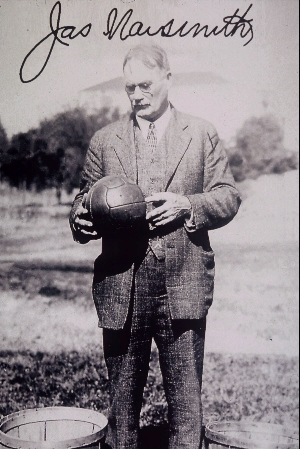![]()
History of BasketballDr. James Naismith, Inventor of BasketballKU Basketball Program Founder
Dr. James Naismith is known world-wide as the inventor of basketball. He was born in 1861 in Ramsay township, near Almonte, Ontario, Canada. The concept of basketball was born from Naismith's school days in the area where he played a simple child's game known as duck-on-a-rock outside his one-room schoolhouse. The game involved attempting to knock a "duck" off the top of a large rock by tossing another rock at it. Naismith went on to attend McGill University in Montreal, Quebec, Canada. After serving as McGill's Athletic Director, James Naismith moved on to the YMCA Training School in Springfield, Massachusetts, USA in 1891, where the sport of basketball was born. In Springfield, Naismith was faced with the problem of finding a sport that was suitable for play inside during the Massachusetts winter for the students at the School for Christian Workers. Naismith wanted to create a game of skill for the students instead of one that relied solely on strength. He needed a game that could be played indoors in a relatively small space. The first game was played with a soccer ball and two peach baskets used as goals. James Naismith devised a set of thirteen rules of basketball:
In addition to the creation of the basketball, James Naismith graduated as a medical doctor, primarily interested in sports physiology and what we would today call sports science and as Presbyterian minister, with a keen interest in philosophy and clean living. Naismith watched his sport, basketball, introduced in many nations by the YMCA movement as early as 1893. Basketball was introduced at the Berlin Olympics in 1936. Today basketball has grown to become one of the world's most popular sports. |
Site author: George Laughead Thanks to the late Dr. Lynn H. Nelson, author of HNSource, the first history site on the WWW.
Return to the Kansas History Web Sites directory or to the Kansas Heritage Group or to WWW-VL: United States History.
Updated: 16 August 2019. Page copyright 2020, George Laughead.